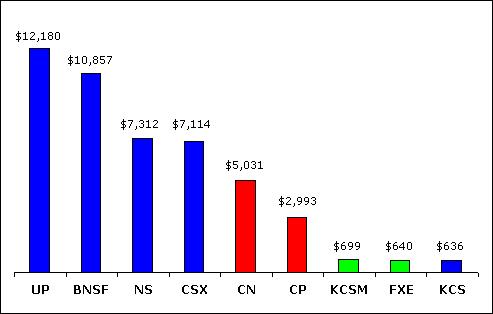| Home | About Us | Resources | Archive | Free Reports | Market Window |
The New Boom in TexMex Railroading Part IIBy
Thursday, September 7, 2006
There are six major railroads in North America. Soon there will be a seventh. As the latest issue of Trains Magazine reports, this “quirky, midsized railroad” is “poised to explode with new business.” Let me preface this message with a quick recap: I’m bullish on the entire railroad industry. Years of under-investment, government legislation and falling demand have left the railroads in tatters. Most of the USA is still covered in single track, so trains can’t travel in both directions. There’s congestion all over the network. Trains run through the middle of towns. They get snarled up in the traffic. There aren’t enough railcars or locomotives. Employees are aging and new recruits are hard to find. In 1920, says the Association of American Railroads, there were 380,000 miles of rail in the USA. Now there are just 170,000 miles. A few years ago, demand for railroad transportation suddenly picked up. The container box is one reason. So is the new popularity of coal. So is a bull market in natural resources and increased trade with China. But the cost of fuel is the big reason. Trains are much more fuel-efficient. One train replaces anywhere from two hundred to five hundred trucks. As I explained, the railroads were not prepared for this boom. I’ve chatted to yard managers from all over the country. The Norfolk Southern dispatcher I spoke to last year in Jacksonville summed up the situation best: “It’s so busy, we’re having to turn down business.” This is great news for railroad stockholders. The price of railroad transportation has to rise for demand to meet supply. Railroad profits have already turned upward and so have their stocks. But fixing a supply-demand imbalance in a monolithic, capital-intensive industry like the railroad will take decades. Therefore, I predict the railroad boom still has years to go. There is one railroad, however, that I expect to perform better than all the others. I’ve written about them before in these pages... we call them the “TexMex Railroad.” Until recently, Kansas City Southern was just an afterthought of the railroad industry. Here’s how they stacked up against the competition in 2004. Railroads in blue are American. Green are Mexican, and red are Canadian. Major North American Railroads By 2004
About ten years ago, KCS started quietly pursuing a new strategy: the conquest of Mexico. The big six already had Canada and the USA sewn up, so for a small railroad with big plans, Mexico was really the only option for expansion. Besides, the Mexican government had just decided to break up its national monopoly of the Mexican rail network and auction off the pieces to private investors. KCS stepped in and started making acquisitions. It bought the largest Mexican railroad, serving a triangle between Mexico City, a deepwater Pacific coast port, and the busiest railroad crossing into the USA. It bought a small South Texas short-line railroad called the Texas Mexican that controlled the tracks on the US side of the same border crossing. And finally, it started uniting tracks and haulage rights in the Southeastern US and eastern Texas. The final result will be a rail link that serves three huge markets, almost without competition:
Right now, the KCS vision is still a work-in-progress. For example, the expansion of Lazaro Cardenas, the Mexican deepwater port, won’t be finished until mid-2007. The route from the port to the border still requires lots of work, with plans to increase passing points and improve the quality of rail. There are bottlenecks in Texas too. Will KCS pull off the most ambitious railroad expansion of the decade? We can only guess. The railroad is still bound by bureaucracy, regulation and barriers to entry. But with the wind behind us in the railroad sector anyway, I’m much more willing to take a bet on it... Good investing, Tom Market NotesA CHART FOR THE CASSANDRAS OF THE WORLD Last week, in a room packed with investors, DailyWealth listened to a speech on the imminent collapse of the U.S. financial system. Mountains of debt and a lack of savings were cited as the killer. We sat silently and disagreed. We’ll listen to the market instead. In this case, “the market” is the share price of the iShares U.S. Financial Sector Fund (IYF). This ETF is made up of financial titans like Citigroup, Merrill Lynch, Goldman Sachs, American Express, and Wells Fargo. These are the companies that prosper when loans are paid back, when businesses expand, and when stocks and bonds are purchased. Today’s chart shows these guys are doing just fine… If the bears are right, we’ll see a big breakdown in this fund. Until that happens, the gloom and doom is just bunk. The money shufflers prosper… the |
Recent Articles
|


